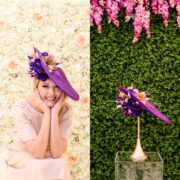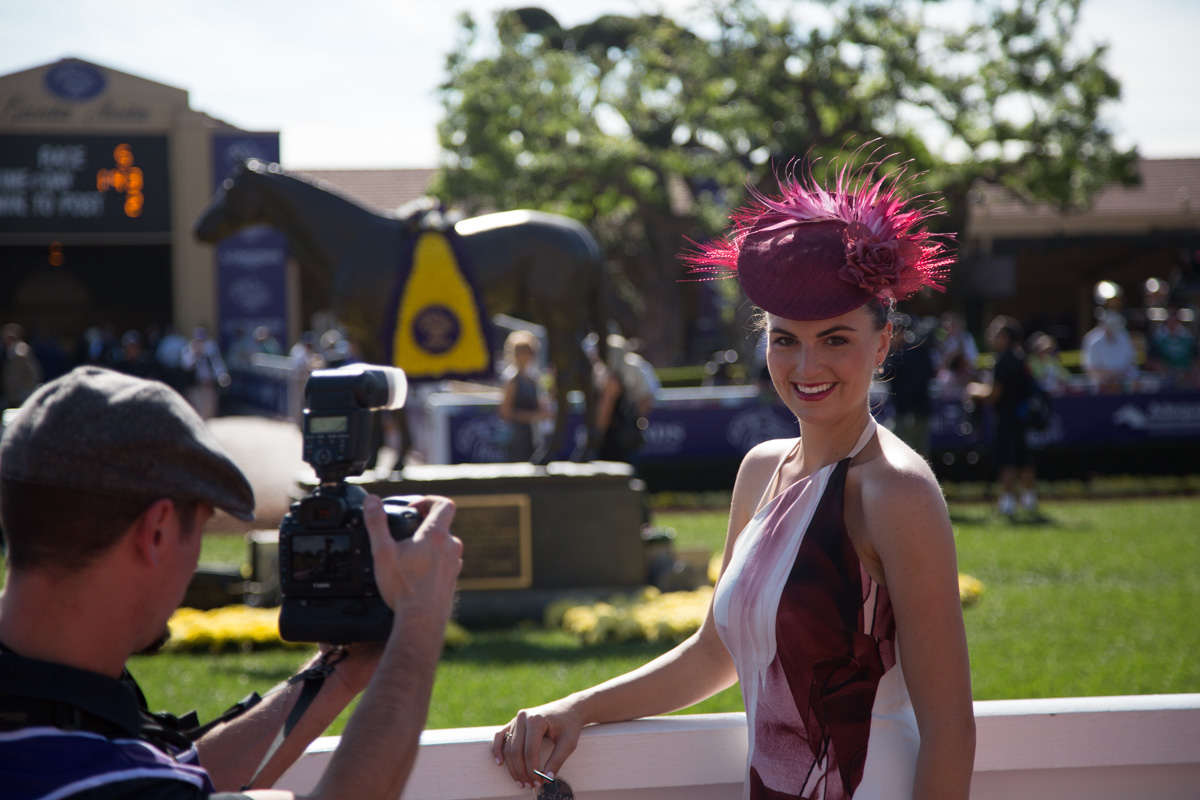Heading into Royal Ascot we know a lot of ladies are looking for the perfect hat or fascinator. We’ve got a step by step article from the talented milliner Lisa Farrell as she creates a gorgeous piece for one of her clients. Check out how its done here:
“ My client is attending Royal Ascot in June, and needs a fascinator to coordinate with the dress she plans to wear to Ladies Day. I took my inspiration for her fascinator from the colors in the dress as well as the floral detail and gold accents. This gave me a very good place to start.”
My client is attending Royal Ascot in June, and needs a fascinator to coordinate with the dress she plans to wear to Ladies Day. I took my inspiration for her fascinator from the colors in the dress as well as the floral detail and gold accents. This gave me a very good place to start.”
“We tried on several different styles and silhouettes to get an idea of what worked  best on her and what she felt most comfortable in. We settled on the fascinator below. I would base my design on this fascinator but strengthen the design so it would be more of an Ascot-worthy piece. I also made sure the fascinator satisfied the Dress Code for Royal Ascot which states that a fascinator base must be 4 inches or larger.”
best on her and what she felt most comfortable in. We settled on the fascinator below. I would base my design on this fascinator but strengthen the design so it would be more of an Ascot-worthy piece. I also made sure the fascinator satisfied the Dress Code for Royal Ascot which states that a fascinator base must be 4 inches or larger.”
“The base of the fascinator is going to be made out of grey pre-sized sinamay from The  Feather Shop. (http://www.thefeathershop.com) I am using 2 layers of sinamay cut a bit larger than the finished fascinator so there’s plenty of sinamay to tug on and pin into while blocking. Better to cut too much sinamay than to find you don’t have enough to get to the edge of the block and make a nice fold over. You can always cut off the excess sinamay.”
Feather Shop. (http://www.thefeathershop.com) I am using 2 layers of sinamay cut a bit larger than the finished fascinator so there’s plenty of sinamay to tug on and pin into while blocking. Better to cut too much sinamay than to find you don’t have enough to get to the edge of the block and make a nice fold over. You can always cut off the excess sinamay.”
“Since I originally blocked this piece on a borrowed block, which I no longer have, I’m going to use the actual fascinator as a block.  It’s stiff enough that I can block on it without doing any damage to it. I have removed the headband and have covered it with plastic to protect it from the water and steam I use when blocking. The plastic also prevents the sinamay from sticking to the block and makes it easier to remove it from the block without distorting the finished shape once it has dried.”
It’s stiff enough that I can block on it without doing any damage to it. I have removed the headband and have covered it with plastic to protect it from the water and steam I use when blocking. The plastic also prevents the sinamay from sticking to the block and makes it easier to remove it from the block without distorting the finished shape once it has dried.”
 “Now I’m ready to block the sinamay. I wet the sinamay until it’s soft enough to manipulate. You don’t want to over-soak the sinamay or you will wash out all the sizing. You also don’t want the sinamay to dry out while you’re working with it so you can rewet it with a spray bottle of water as you go. Steam also helps to soften the sinamay until it takes the shape of the block. When blocking on an actual hat, I use straight pins instead of pushpins to secure the sinamay to the block. Straight pins won’t damage the fascinator. I block one layer of sinamay then turn the next layer 45 degrees from the first before placing it on the block. Once you’re satisfied with how the sinamay is blocked and it’s all nice and smooth, allow the sinamay to dry thoroughly.”
“Now I’m ready to block the sinamay. I wet the sinamay until it’s soft enough to manipulate. You don’t want to over-soak the sinamay or you will wash out all the sizing. You also don’t want the sinamay to dry out while you’re working with it so you can rewet it with a spray bottle of water as you go. Steam also helps to soften the sinamay until it takes the shape of the block. When blocking on an actual hat, I use straight pins instead of pushpins to secure the sinamay to the block. Straight pins won’t damage the fascinator. I block one layer of sinamay then turn the next layer 45 degrees from the first before placing it on the block. Once you’re satisfied with how the sinamay is blocked and it’s all nice and smooth, allow the sinamay to dry thoroughly.”

“After the sinamay is thoroughly dry, you can begin to work with it. While the sinamay is still pinned in place, trim away the excess sinamay, leaving about an inch all around the finished edged.”
“Unpin the base and carefully remove the sinamay base from the block. Next gently finger press the fold over edge, and the base is now ready for wiring.”

“The outside edge of the base is wired to help the base keep its shape. Take a piece of #19 covered millinery wire slightly longer than needed. Place it inside  the channel and determine the precise length needed. Cutting the wire the correct length is crucial. Too long and the wire will distort the shape, too short and the wire will come out of the joiner and the base will sag. Once the correct length has been determined, join the wire to form a circle with a metal joiner secured with a touch of glue. Crimp the joiner into place with a pair of pliers. ”
the channel and determine the precise length needed. Cutting the wire the correct length is crucial. Too long and the wire will distort the shape, too short and the wire will come out of the joiner and the base will sag. Once the correct length has been determined, join the wire to form a circle with a metal joiner secured with a touch of glue. Crimp the joiner into place with a pair of pliers. ”
“Place the wire in the outside edge channel, fold over the edge again to cover the wire and pin.”

“Pin in the wire all around the outside edge.”
“Machine stitch the wire very close to the finished edge of the base so the wire won’t move. The wire will help the base keep its shape and create a nice clean finished edge.”

“Trim the excess away, very close to the stitch line.”
“Bind the outside edge with a grey sinamay bias strip from The Feather Shop. Fold the bias strip in half and pin over the wired edge. This will give the outside edge a nice clean and finished appearance.”
“Machine stitch the bias strip close to the outside edge of the bias strip.”

Finished sinamay base ready for trimming.
“The next step is to add the headband. I wrap the metal headband with floral tape; gently pulling the tape as I go so the tape will stick to itself and cover the headband neatly. I cover the headband to make it more comfortable for the client and to give me something to sew into.”

“Next I wrap the headband with a 1” bias strip of silk with one edge folded up ¼” in a color to  match the client’s hair color, which in this case is blond. I place one end of the headband in the folded edge and begin wrapping the bias strip around the headband. I wrap about 2/3’s of the way up and stitch it down. I begin wrapping the same way from the other end and wrap the remaining 1/3 of the headband until the ends meet so the entire headband is covered. These stitches will be covered with a
match the client’s hair color, which in this case is blond. I place one end of the headband in the folded edge and begin wrapping the bias strip around the headband. I wrap about 2/3’s of the way up and stitch it down. I begin wrapping the same way from the other end and wrap the remaining 1/3 of the headband until the ends meet so the entire headband is covered. These stitches will be covered with a  strip of bias sinamay, which attaches to the base.”
strip of bias sinamay, which attaches to the base.”
“Use a bias strip of sinamay to attach the headband to the sinamay base. Take a 3” piece of the grey sinamay bias strip and place over the stitches approximately 3-1/2” up from one end. Stitch the bias strip securely to the underside of the headband. The headband is now ready to be securely stitched onto the underside of the base. Decide on correct placement of the headband by trying on the base and headband until you find the most attractive angle for the base and pin the two elements together. Securely stitch the base and the headband together. Don’t worry if the stitches show on the topside of the base. They will get covered with trim.”

“Now the base is ready for trimming. I want to make two bows out of the coral sinamay. I cut two 8’ wide bias strips of sinamay. Also cut two tales for the bow using the same method”
 “Turn under the outside edges ¼” and finger press. Turn the outside edges once again ¼’ and finger press. Fold in half and make a bow using steam to help form an attractive shape. Make two of these. Use the same method to make the two bow tales.”
“Turn under the outside edges ¼” and finger press. Turn the outside edges once again ¼’ and finger press. Fold in half and make a bow using steam to help form an attractive shape. Make two of these. Use the same method to make the two bow tales.”
“Cross the bow loops, find the proper placement for the bow and stitch into place. Add the bow tales and stitch into place. Tack the ends of the bow tales in place.”
“Take the gold sinamay bias strip from The Feather Shop and loop the strip into  place in a diagonal line. This creates movement and tension within the design. Diagonal lines are always more interesting than horizontal and vertical lines so I try and create them within a design whenever possible. ”
place in a diagonal line. This creates movement and tension within the design. Diagonal lines are always more interesting than horizontal and vertical lines so I try and create them within a design whenever possible. ”

“Gold sinamay loops stitched in place. Notice the number of angles in the overall design.”

“Another way to create diagonal lines is with feather curls. I use an ostrich feather and carefully cut it down to about ¼” on either side of the spine.”

“To curl the feather, first steam the feather to soften the spine. Then use a hot curling iron to carefully and gently curl the feather until satisfied with the shape.”
“Finally stitch down the remaining trim: a feather mount and feather flower from The Feather Shop and accent it all with a dollop of ivory ostrich feathers, and there you have it! The perfect Ascot fascinator! It has the same basic shape as the black fascinator we originally decided upon but with that extra bit of drama and excitement to make it the perfect piece for Royal Ascot!”






